I have had several camera and equipment bags over the years, ranging from simple backpacks to over-the-shoulder models, to free bags that came with gear I bought. While all of them have been effective to varying degrees, each one has had its own share of problems. Some are too bulky, while others are not big enough. Some have pockets in strange places, and others have no pockets at all. Some have nicely-padded straps and big cushions for gear, but these usually result in bags that are too cumbersome and awkward for everyday use.
In short, while all the bags I have used have been functional, none of them have been very well designed with a photographer’s needs in mind. Enter the Everyday Messenger Bag by Peak Design.
I first heard about this bag on an episode of This Week in Photo, where host Frederick Van Johnson interviewed Trey Ratcliff, a well-known photographer who was similarly frustrated with the state of modern camera carrying equipment. Ratcliff had been working with Peak Design to create a bag that was ideally suited for not just photographers, but anyone who would need to carry various things around on a daily basis. By the end of the podcast I was intrigue,d and within a few days my wife and I backed Ratcliff’s project on Kickstarter.
However, like some of the other projects we had supported, we were not sure if our pledge would result in a high-quality product, or simply evaporate into cyberspace never to be heard from again. Thankfully Ratcliff and Peak Design held true to their word, and at the end of November our Everyday Messenger arrived, and we have been using it quite a bit ever since.
Thoughtful Design
At first glance the Everyday Messenger looks just like any other bag of its kind; it’s big enough for some cameras, a lens or two, and a laptop and/or tablet. There are pockets, a padded strap, and some zippers to let you access everything. In fact my initial reaction to the bag was a bit of a disappointment. Why spend more than $200 on a bag that seems the same as a $50 bagthat I could buy from Amazon or a department store?
The answer, I discovered after using it for a while, lies in the details. While not perfect, there are many subtle aspects to this bag that you just don’t normally see on other camera bags, which make the Everyday Messenger imminently more practical for photographers.
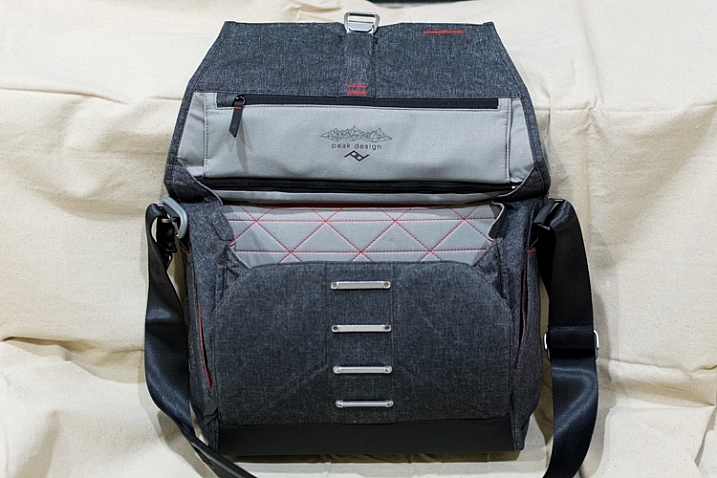
“She may not look like much, but she’s got it where it counts” – Han Solo, describing either the Millennium Falcon or his Everyday Messenger bag.
One of the biggest hassles with my other camera bags has been actually getting things out of the bag. Usually it involves unbuckling a clasp, and fiddling with a zipper that goes around a few sides of the bag, to reveal the gear stuffed inside. It’s a cumbersome maneuver that can be anywhere from mildly irritating to downright frustrating, especially in the middle of a photo shoot.
The Everyday Messenger solves this with a magnetic clasp that hooks to one of four positions, releases with a quick flick of your wrist, and snaps securely back in place with minimal effort. It also has two weather-sealed zippers on top; one which provides access to the main pouch and another for the laptop/tablet storage section in the back. All this adds up to a bag that is clearly designed to hold your equipment safe and secure, while letting you get at it as quickly as possible, and has quickly made all my other bags look archaic by comparison.
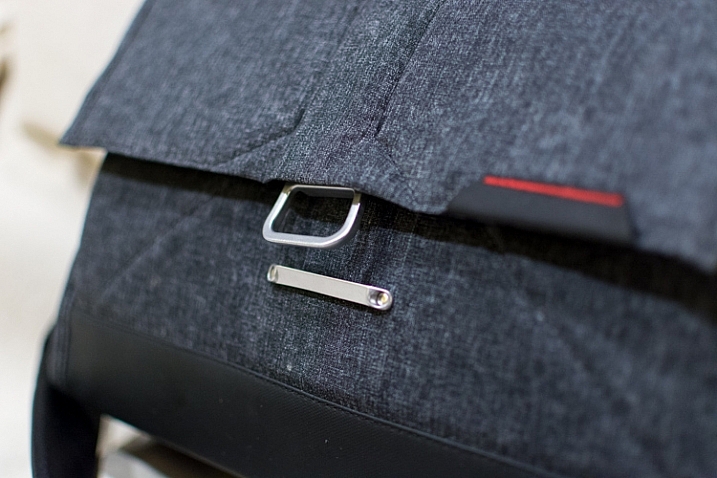
The front clasp opens and closes easily, but locks securely. I thought it would be gimmicky at first, but it has turned out to be surprisingly useful, and quite durable.
Attention to Detail
There are dozens of little examples like this scattered throughout the Everyday Messenger bag that make it incredibly useful for photographers, as well as anyone else who needs a bag to carry things around. In fact my wife, a college professor, has been using it to carry all manner of papers and books, along with her laptop, around campus. After a week of using it she said, and I quote, “My official verdict is – it’s awesome.”
The clasp on the shoulder strap adjusts with a quick release mechanism to make it longer or shorter, and even the strap itself is unique in its design. Instead of a shoulder pad that slides back and forth, a 15-inch section of the shoulder strap is padded from the inside. This not only eases much of the stress on my shoulder, but is far more comfortable than any other camera bag strap I have ever used. The strap seems well suited for those who like over-the-shoulder bags, but can also be made long enough to accommodate users who prefer to sling the bag across their chest.

If you want pockets, this bag has plenty to spare.
The little touches don’t stop with the shoulder strap and zippers. Two pockets on each side of the bag offer quick access to small things like lens filters, batteries, or even keys, which can be clipped to a security strap so they won’t get lost. Inner pockets in the lining of the bag are coded red and green, and are designed for memory cards or batteries that are either ready to go or all used up. The shoulder strap attaches to the bag itself with a rotating joint, instead of the common swivel style you see on most bags, which means the Everyday Messenger moves naturally at your hip instead of jostling back and forth. And unlike almost every other messenger-style bag I have used, this one stands perfectly upright whether empty or full, thanks to a thick underlining.
All of this adds up to a bag that carries your stuff like any other, but does so in a way that is more practical and easier to use than you might expect.
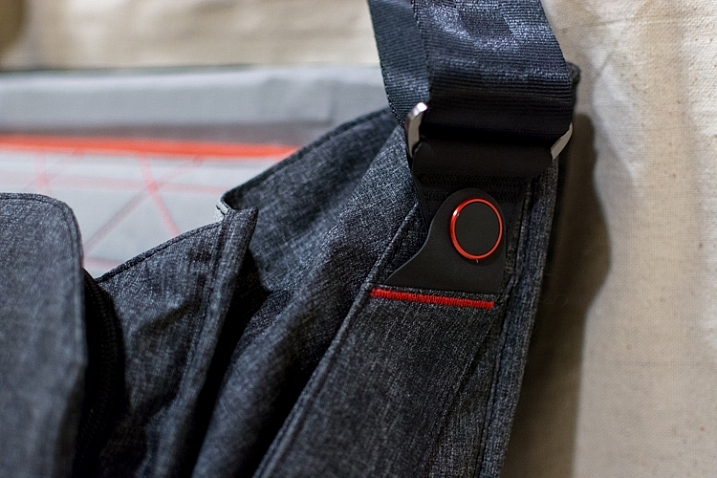
The shoulder strap rotates front to back where it is attached to the bag, which makes things far more comfortable on long walks than most other bags.
The inside of the Everyday Messenger looks like what you would expect – a big empty compartment, with velcro dividers to keep your larger gear items separate from each other. Unlike most other bags though, the creators added a somewhat unique twist on the dividers themselves; they are designed to fold and flex in order to accommodate oddly-sized equipment and even let you stack things on top of one another. If you have a larger lens it can be placed on the side, and multiple camera bodies can be put next to it, or stacked on top of each other, with everything padded on all sides. These dividers make the bag far more practical for photographers, as compared to traditional rectangular or messenger-style bags, but I should note that the dividers themselves do seem a tad flimsy compared to other bags I have used. Thus far they seem fine, but I wonder how well they will hold up after several months of daily use.
Of course a camera bag is more than the sum of its features, and all the padding, pockets, and clever nooks and crannies in the world don’t matter if the bag is uncomfortable out in the field. Thankfully the Everyday Messenger does quite well in this regard. The padded neck strap and thick cross-bracing on top distribute the weight of the bag evenly, and even with a laptop, a camera, and some lenses in the bag, it was still fairly portable and easy to use. As with other aspects of the bag, only time will tell how it handles in the long run, but for now I can safely say that this one is much more comfortable and user-friendly than almost every other I have used.
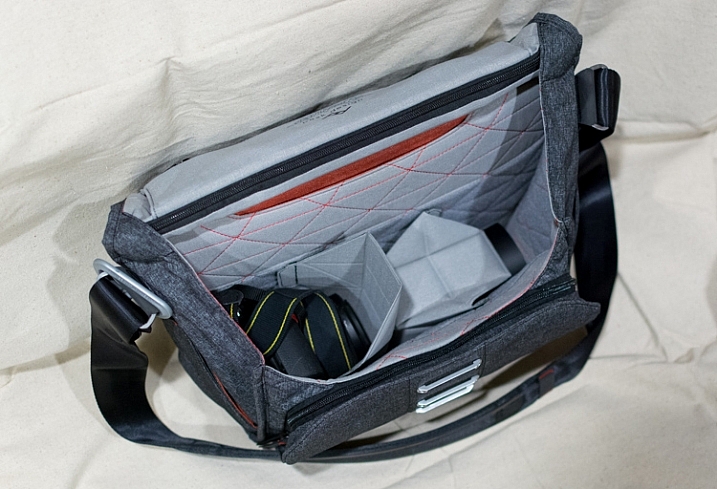
Thanks to the folding dividers I can pack a DSLR with lens attached, another lens on the side, and still have a large padded cavity on top of the extra lens for my flash or other items.
The only reservations I have about wholeheartedly recommending this bag relate to its price, and overall durability. Peak Design claims it is made of: Weatherproof waxed 500D Kodra, which is used in many outdoor-related products, and even some military applications as well. It does feel a bit thin, so like the internal dividers, I do wonder if the bag is suited for the long haul. However, I don’t think it would necessarily be any worse than any other bag I have owned.
Finally, one of the most basic questions about this bag involves the price – is it really worth $250? That depends on your needs. Certainly that amount will fetch you one, or even several, perfectly fine camera bags from manufacturers like Lowepro, Ruggard, Crumpler, Tamrac, and many others. While all those bags are nice, and much less expensive, I have found the Everyday Messenger to be more enjoyable to use on a daily basis. It won’t hold as much equipment as some other bags, so if you are a professional who needs the most amount of space for all sorts of gear, you might want to look elsewhere. But if you’re a casual photographer, who likes to transport your gear on a regular basis, I can confidently recommend the Everyday Messenger Bag.
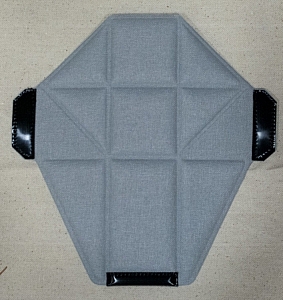
These oddly-shaped dividers are quite handy, though they do feel a bit thin and flimsy compared to some dividers in other camera bags.
Pros:
- Well thought out design
- Lots of storage for a variety of camera gear
- Sturdy, rugged, and waterproof
- Stands upright on its own, empty or fully loaded
- Ingenious front clasp, along with top zippers, make accessing your gear very easy
Cons:
- Material is slightly thin and might wear out over time
- Price is a bit high
The post Review: The Everyday Messenger Bag by Peak Design by Simon Ringsmuth appeared first on Digital Photography School.
from Digital Photography School http://digital-photography-school.com/review-the-everyday-messenger-bag-by-peak-design/
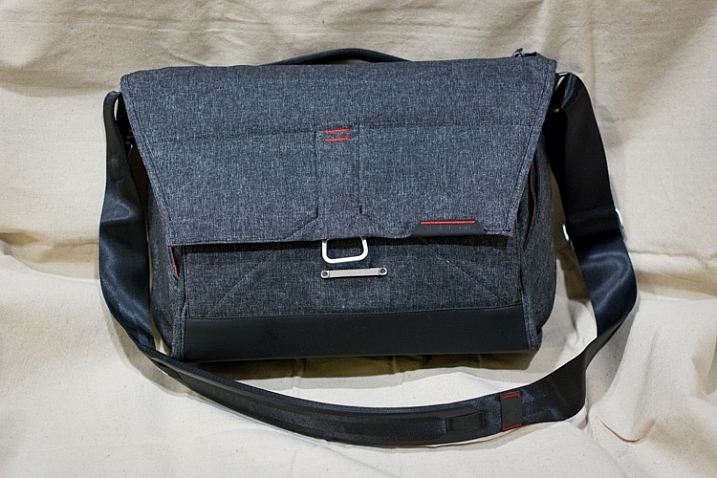
No comments:
Post a Comment